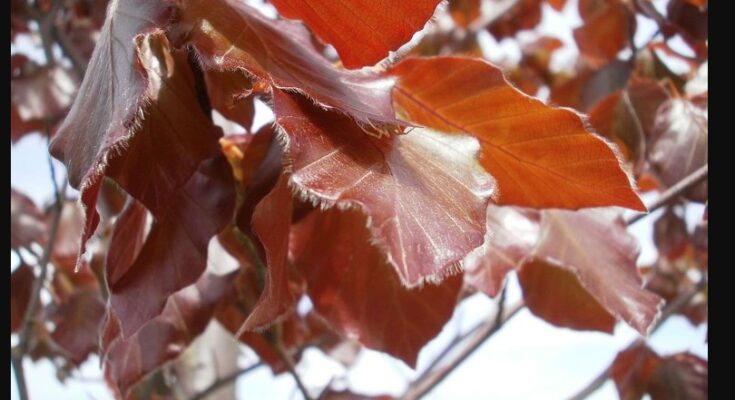Contents
- 1 Introduction To Copper Beech
- 2 1. What is a Copper Beech?
- 3 2. History and Origins
- 4 3. Characteristics of Copper Beech Trees
- 5 4. Benefits of Planting Copper Beech
- 6 5. How to Plant a Copper Beech Tree
- 7 6. Caring for Your Copper Beech
- 8 7. Common Pests and Diseases
- 9 8. Pruning and Maintenance
- 10 9. Copper Beech in Landscaping
- 11 10. Seasonal Changes and Appearance
- 12 11. Environmental Impact
- 13 12. Interesting Facts About Copper Beech
- 14 13. Copper Beech Varieties
- 15 14. FAQs About Copper Beech
- 16 15. Conclusion
Introduction To Copper Beech
Have you ever walked through a park or garden and noticed a tree with stunning, dark purple leaves? That’s likely a copper beech.
These majestic trees are visually striking and have a rich history and many benefits.
This comprehensive guide explores everything you need to know about copper beech trees, from their origins and characteristics to planting and care tips.
1. What is a Copper Beech?
A copper beech, scientifically known as Fagus sylvatica purpurea, is a type of European beech tree. It is renowned for its striking foliage, which ranges from deep purple to coppery-red, making it a popular choice for gardens and parks.
2. History and Origins
Ancient Roots
The copper beech tree originates from Europe, where it has been cultivated for centuries. It is a mutation of the common beech tree (Fagus sylvatica).
Introduction to the UK
Copper beech was introduced to the UK in the 18th century and quickly became a favorite among landscapers and gardeners due to its unique and vibrant foliage.
3. Characteristics of Copper Beech Trees
Size and Shape
Copper beech trees are large, deciduous trees that can grow up to 40 meters tall. They have a broad, spreading canopy and smooth, gray bark.
Leaves and Flowers
The copper beech’s most distinctive feature is its rich, purple leaves. In spring, the tree produces small, inconspicuous flowers that give way to beech nuts in the fall.
Growth Rate
Copper beech trees grow moderately to quickly, making them a substantial presence in any landscape over time.
4. Benefits of Planting Copper Beech
Aesthetic Appeal
The striking foliage of copper beech trees adds a unique visual element to any garden or park.
Shade and Shelter
With their broad canopies, copper beech trees provide ample shade and can act as a windbreak, making them ideal for creating sheltered garden areas.
Wildlife Habitat
Copper beech trees support a variety of wildlife, providing food and shelter for birds, insects, and small mammals.
5. How to Plant a Copper Beech Tree
Choosing the Right Location
Select a location with well-drained soil and ample growing space for the tree. Copper beech trees thrive in full sun to partial shade.
Planting Steps
- Dig a Hole: Dig a hole twice the width of the tree’s root ball and just as deep.
- Prepare the Soil: Mix the soil with compost to improve drainage and nutrient content.
- Plant the Tree: Place the tree in the hole, ensuring the root ball is level with the ground.
- Backfill and Water: Fill the hole with soil, firm it down, and water thoroughly.
6. Caring for Your Copper Beech
Watering
Water the tree regularly during its first year to establish a robust root system. Once established, copper beech trees are relatively drought-tolerant.
Fertilizing
Fertilize the tree in early spring with a balanced fertilizer to support healthy growth.
Mulching
Apply a layer of mulch around the tree’s base to retain moisture and suppress weeds.
7. Common Pests and Diseases
Aphids
Aphids can infest copper beech trees, sucking sap from the leaves and causing them to curl and distort.
Beech Scale
Beech-scale insects can attack the bark, leading to the growth of sooty mold.
Disease Management
Regularly inspect the tree for signs of pests and diseases and treat them promptly with appropriate insecticides or fungicides.
8. Pruning and Maintenance
When to Prune
Prune copper beech trees in late winter or early spring before new growth begins.
How to Prune
Remove dead or diseased branches and thin out crowded areas to improve air circulation and sunlight penetration.
9. Copper Beech in Landscaping
Focal Point
Due to their striking appearance, copper beech trees make excellent focal points in large gardens or parks.
Hedging
Copper beech trees can also be used for hedging, providing a colorful alternative to traditional green hedges.
10. Seasonal Changes and Appearance
Spring and Summer
In spring, copper beech leaves emerge a vibrant purple, deepening to a rich burgundy in summer.
Autumn
In autumn, the leaves turn coppery-red before falling, adding seasonal interest to the garden.
11. Environmental Impact
Carbon Sequestration
Like all trees, copper beech trees absorb carbon dioxide, helping to mitigate climate change.
Soil Improvement
Their fallen leaves decompose and enrich the soil, improving its structure and fertility.
12. Interesting Facts About Copper Beech
- Historical Significance: Copper beech trees have been used in landscaping since the 18th century.
- Longevity: These trees can live for several hundred years, providing beauty and shade for generations.
- Symbolism: In some cultures, beech trees are symbols of wisdom and longevity.
13. Copper Beech Varieties
Purple Fountain Beech
This variety has a weeping form with cascading branches and deep purple leaves.
Riversii
The Riversii variety is known for its dark foliage and upright growth habit.
14. FAQs About Copper Beech
What is a copper beech tree?
A copper beech tree is a type of European beech known for its striking purple foliage and large size.
How fast do copper beech trees grow?
Copper beech trees grow moderately to quickly and can reach up to 40 meters in height.
How do you care for a copper beech tree?
You can care for a copper beech tree by watering it regularly, fertilizing it in early spring, and applying mulch to retain moisture.
What pests affect copper beech trees?
Common pests include aphids and beech scale insects, which can be managed with appropriate treatments.
Can copper beech trees be used for hedging?
Yes, copper beech trees can be used for hedging, providing a colorful and attractive alternative to traditional green hedges.
15. Conclusion
Copper beech trees are a magnificent addition to any landscape, offering aesthetic appeal, environmental benefits, and a rich history.
Whether you want to plant a single tree as a focal point or create a stunning hedge, copper beech trees provide a unique and beautiful option.
Proper care and maintenance allow these trees to thrive for centuries, adding beauty and value to your garden or park.
By understanding the benefits and features of copper beech trees, you can make an informed decision that enhances your outdoor space and provides enjoyment for generations to come.
If you gained new insights from this article, explore our blog, Gimkit, for more enlightening content.



